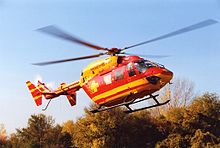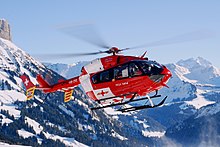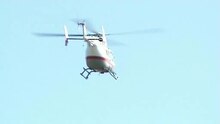MBB / Kawasaki BK 117
| BK 117 | |
|---|---|
 The BK 117 as a rescue helicopter The BK 117 as a rescue helicopter
|
|
| Type: | Multipurpose helicopter |
| Design country: | |
| Manufacturer: |
|
| First flight: |
June 13, 1979 |
| Commissioning: |
December 9, 1982 |
| Production time: |
In series production since 1979 |
| Number of pieces: |
Germany (status 11/2015): |
The BK 117 is a light twin-engine multi - purpose helicopter that was created in 1979 in a joint production of the German manufacturer Messerschmitt-Bölkow-Blohm (MBB) and the Japanese Kawasaki Heavy Industries (KHI). The successor model, the enlarged and modernized version BK 117 C-2 , called EC145 by Airbus Helicopters (formerly Eurocopter) , had its first flight in 2000. Today the manufacturer operates under the name Airbus Helicopters. All versions were also built in Japan, the BK 117 C-2 (EC145) and the BK 117 D-2 (H145) are also in production there.
history

The aim in developing the helicopter was to continue using as many tried and tested components as possible from the previous Bölkow Bo 105 model, while at the same time keeping up with the latest technology and creating more space in the interior. The cramped space conditions in the Bo 105 had proven to be a hindrance at times, especially during rescue operations. The cooperation agreement between MBB and KHI was signed by Ludwig Bölkow and Teruaki Yamada on February 25, 1977. It stipulated that MBB should develop the new main rotor including the associated control components and KHI the cell and the main gearbox. The development costs of an estimated 100 million US dollars have been divided equally. On June 13, 1979 the first flight of the prototype P2 of the BK 117 took place in Ottobrunn . This prototype still exists today and can be viewed in the Bückeburg helicopter museum.
MBB later merged as part of Daimler-Benz Aerospace (DASA) together with the French Aérospatiale in the new company Eurocopter , whose program still includes the BK 117 - now in the BK 117-C2 variant known as EC145 . The model BK117 D2 was sold until March 2015 under the product name EC145 T2. Since then, the latest T2 variant has been sold under the product name H145. An upgrade of the rotor system was presented in 2019. The previously used 4-blade system with a titanium head is being replaced by a headless 5-blade system. Compared to its predecessor, the ATR system (advanced technology rotor) is supposed to produce fewer vibrations, a shorter blade length, a lower empty weight and a higher payload. It allows the sheets to be folded for transport and facilitates storage. This expansion stage is carried under the product name BK117 D3.
The BK 117 is mainly used in the areas of air rescue and intensive care transport or as a police helicopter . Equipment packages from the manufacturer or from third-party suppliers such as B. a winch available. This also enables the helicopter for the SAR service in difficult to access terrain. In Germany, the air rescue of the ADAC and the DRF air rescue have the largest contingents, in Spain the Guardia Civil ; in France the gendarmerie is equipped with the EC145, among other things. It was or is still in military use in some states, such as Iraq and South Africa or the United States (see UH-145).
In April 2013, Eurocopter demonstrated unmanned flights at the French air force base in Istres with an Optionally Piloted Vehicle EC145 . The flight profile contained automatic take-offs and landings, flights along a route specified by waypoints, and the placement of an external load hanging under the helicopter . The helicopter was controlled from a ground station.
Versions

The technical data refer to the document TCDS R.010 of the European Aviation Safety Agency .
BK 117 A-1, -A-3, -A-4
The BK 117-A model with the Lycoming LTS 101-650B-1 turbine was approved by the German Federal Aviation Office (LBA) on December 9, 1982 . The version A-3 retained the engine and received its certification on March 15, 1985 for additional specialized tasks and optional equipment. The A-4 version was registered on July 29, 1986 with the same turbine.
BK 117-B-1
The B-1 received approval on December 10, 1987 with the current LTS 101-750B-1 gas turbine from Honeywell-Lycoming.
BK 117 B-2
Approved on January 17, 1992, also powered by the LTS 101-750B-1 engine; with 598 liters of usable tank capacity.
BK 117 C-1
The BK 117 C-1 has two Turbomeca Arriel 1E2 (516 kW) turbines , an improved tail rotor and - with 697.4 liters of usable fuel as standard - more range. The helicopter has a take-off mass increased by 150 kg , achieves better altitude performance and was approved on October 2, 1992. In 2002, production was relocated to Trento in northern Italy in order to make room for the new BK 117 C-2 and EC 135 models in the German plant. The last helicopters of this series were produced in 2004 and handed over to the NRW police force. The last delivery of a BK 117 C-1 took place in 2005 and went to a customer in Mexico. After that, only the new Eurocopter EC 145 (BK 117 C-2) model was built.
EC 145 (BK 117 C-2)
From the mid-1990s an enlarged version of the BK-117 series was developed; it is offered by Eurocopter Germany as Eurocopter 145 (EC 145) and by Kawasaki (KHI) as BK 117 C-2. In Germany, the EC 145 received type certification on December 20, 2000.
The new model has an extended cabin. The basic concept with side sliding doors and split rear door was retained. The front area has a similar appearance to the smaller EC 135. A new electronic flight instrument system can optionally be used in the cockpit . The exposed tail rotor of the BK 117-C1 was also adopted. By redesigning the main rotor, flight performance could be increased compared to the BK 117. The rotor is not without bearings as in the EC 135, but the helicopter is considerably cheaper than its sister model and also quieter than the BK 117 C-1. The helicopter is often used at home and abroad by the police, civil defense and air rescue, and it is often equipped with instruments for IFR . The machine is driven by two Turbomeca Arriel 1E2 turbines with 692 WPS continuous output. Instead of a FADEC control, the drives use a VARTOMS (Variable Rotor speed and Torque Matching System).
H145 (BK 117 D-2, up to 04/2015: EC 145 T2)
From July 2010 flight tests with a new helicopter were started at the Eurocopter factory in Donauwörth. A boom with a Fenestron rear rotor was attached to the cell of the EC 145 with the serial number 9002 . After long speculation in the scene with the type designation EC 146 (which, however, would contradict the original designation scheme of the Eurocopter company), the helicopter with the new type designation EC 145 T2 was presented at the Heli-Expo in Orlando on March 6, 2011 . It will receive engines from the new Turbomeca Arriel2 + family ( Arriel 2E ). These are 25% more powerful and cheaper to maintain than the previous engines of the EC 145. They are fully digitally controlled with FADEC two-channel technology, and the gears for the main and Fenestron tail rotors have been reinforced. The avionics are also being improved, with a four-axis autopilot installed as standard and the modular, expandable display system in the cockpit has three large color displays. The further development of the EC 145 (BK 117 C-2) is approved as BK 117 D-2 . These further developments increase the payload / payload or the power output for flights under hot and high environmental conditions . In addition, the use of the fenestron reduces noise emissions . The first delivery of this version was planned for 2013. In April 2014, the EC 145 T2 received its certification from EASA . The first of around 100 orders to date should be delivered to customers from late summer 2014. At the beginning of August 2014, the first helicopter was handed over to DRF Luftrettung . This was transferred to Munich on December 22nd, 2014 after the completion of the expansion work and has been used as Christoph Munich ever since . Further machines are to fly later at the locations of HDM Luftrettung (subsidiary of DRF).
H145 (BK 117 D-3 / D-3m)
At the Heli-Expo 2019 in Atlanta , Airbus Helicopters presented the BK117 D-3 with a five-blade main rotor as an improved, 50 kg lighter version of the H145 with 100 kg increased maximum take-off mass and 150 kg higher payload. An H145 with a five-blade rotor landed on September 25, 2019 during an altitude test flight on the summit of the 6961 m high Aconcagua .
On July 15, Airbus Helicopters received type certification for the D-3 and D-3m variants from EASA.
Military variants
- The EC 145 was marketed as the UH-145 and won a US Army tender which it designated as the UH-72.
- The name for the militarized version of the EC 145 T2 was EC 645 until March 2015 . Since then, the military version of the H145 has been marketed under the product name H145M. Military users of the H145 are listed with the H145M.
Technical specifications
| Parameter | MB-BK117 B-2 | MB-BK117 C-2 (EC 145) | MB-BK117 D-2 (H145) | MB-BK117 D-3 (H145) | |
|---|---|---|---|---|---|
| Engines | 2 × Avco Lycoming LTS 101 -750B-1 with 410 kW each | 2 × Turbomeca Arriel 1E2 with 516 kW each | 2 × Turbomeca Arriel 2E each with 360 kW (MCP) / 753 kW (OEI) 483 PS (MCP) / 1010 PS (OEI) |
||
| Flight performance | Top speed | 150 kts / 278 km / h | |||
| Cruising speed | 250 km / h | 241 km / h * | |||
| Max. Range | 550 km without reserve | 700 km without reserve * 875 km with additional tank * |
|||
| consumption | 303.8 l / h at maximum speed * 277.7 l / h at cruising speed |
244 kg / h cruising * 258 kg / h at max. Power * |
|||
| Hover | ? | 3400 m | 4877 m | ||
| Service ceiling | ? | 5300 m | 6095 m | ||
| Rate of climb | ? | 8.4 m / s | |||
| Crowds | Max. Takeoff mass | 3350 kg | 3585 kg | 3650 kg / 3700 kg / 3800 kg | +100 kg |
| Empty mass | 1723 kg | 1792 kg |
-50 kg |
||
| payload | 1670 kg | 1793 kg | +150 kg | ||
| Dimensions | Length over all | 13.00 m | 13.03 m | ||
| Length of the cell | 9.90 m | 10.19 m | Hull: 6.17 m | ||
| width | 2.71 m | 3.12 m (hull: 1.96 m) | Hull: 1,845 m | ||
| Height above everything | 3.36 m | 3.95 m | Hull: 3.45 m | ||
| Main rotor diameter | 11.00 m (four-leaved) | 10.80 m
(five-leaved) |
|||
| Tail rotor diameter | 1.956 m | 1.15 m | |||
| Cabin (L × W × H) | ? | 3.12 x 1.70 x 1.27 m | |||
| other data | Sound level | 120 dB | ? | 84.7-90.3 dB | |
| Passengers | up to 11 people (including crew) | ||||
| Tank capacity | 607 l Jet A-1 | 879 l | 915.8 L. | ||
See also
Web links
- Type certificate of MBB-BK 117 - EASA-TCDS-R.010 (PDF; 563 kB)
- BK 117 and EC 145 in air rescue
- EADS North America UH-72A website
Individual evidence
- ↑ a b Technical data sheet ( Memento from November 11, 2006 in the Internet Archive ) on eurocopter.com (PDF file; 1.78 MB)
- ↑ a b Airbus Helicopters launches 5-bladed H145 upgrade (English)
- ↑ eurocopter.com: Eurocopter validates its optionally piloted helicopter capabilities with successful unmanned EC145 demonstration flights at Istres, France. (No longer available online.) Archived from the original on May 3, 2013 ; accessed on May 29, 2019 .
- ↑ Dominic Perry: Eurocopter demonstrates unmanned EC145. In: FlightGlobal. April 25, 2013, accessed April 26, 2013 .
- ↑ EASA: Type Certificate Data Sheet R.010 BK117. (PDF) Retrieved February 19, 2014 .
- ↑ Flug-Revue, 2001, accessed on April 12, 2010 ( Memento from February 6, 2010 in the Internet Archive )
- ↑ Police Aviation News (PDF file; 1.3 MB)
- ↑ Helihub.com , title: Eurocopter launches EC145T2 (not the EC146).
- ↑ Eurocopter presents the EC145 T2 . In: Fliegerrevue . April 2011, pp. 20-22.
- ↑ Certification of the new EC145 T2 from Airbus Helicopters: start of delivery planned for the third quarter. (No longer available online.) Airbus Group, April 17, 2014, archived from the original on April 21, 2014 ; accessed on May 29, 2019 .
- ↑ The world's first EC 145 T2 helicopter goes to DRF Luftrettung . In: DRF Luftrettung . July 31, 2014.
- ↑ Flying change with Christoph Munich . In: YouTube . 22nd December 2014.
- ↑ The world's first EC 145 T2 handed over to DRF Luftrettung. rth.info, accessed August 22, 2014 .
- ↑ H145 on the Andean summit . In: Michael Pfeiffer (Ed.): Flug Revue . No. 12 . Motor Presse Stuttgart , Stuttgart 2019, p. 7 .
- ↑ EASA: EASA.R.010, Issue 17. In: TCDS of EASA. EASA, July 19, 2020, accessed on July 29, 2020 .
- ↑ Osborne, Tony: "Airbus Leans On New Rotor Blade Tech For Light Helicopter Upgrade" , Aviation Week, March 4, 2019. Retrieved March 10, 2019, 7:12 p.m. CET. (English)
- ↑ Type Certificate. (PDF) easa.europa.eu, accessed on February 28, 2015 .






